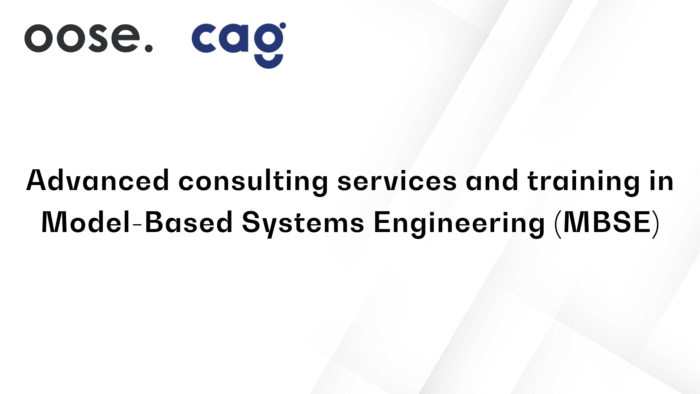Unlocking the Power of MBSE and SysML (Day 1)
1-day course for Business and Product Managers, Technical Project Managers, System Engineers
Modern systems are growing in complexity, integration, and pace of change—placing immense demands on how we develop and manage them. Traditional document-centric approaches are no longer sufficient to ensure consistency, traceability, or agility across the system lifecycle.
This one-day course is designed to introduce Model-Based Systems Engineering (MBSE) and the SysML modeling language to business leaders, technical managers, and engineers seeking to modernize their engineering practices.
Learn what MBSE is and why it matters from a business value perspective. Discover how MBSE:
- Improves cross-team collaboration and decision-making
- Reduces risk through earlier validation and traceability
- Enables more effective product lifecycle governance
- Aligns with digital transformation and sustainability initiatives
We will also explore how MBSE can be introduced incrementally and sustainably within your organization.
Gain a clear understanding of the SysML language—the foundation of MBSE practice. This includes:
- Key modeling constructs and diagrams
- Practical examples from real-world systems
- The transition from SysML v1 to v2 and the opportunities this evolution brings for greater expressiveness, modularity, and automation
Whether you’re leading change or implementing systems, this course offers a practical and strategic perspective on how to apply MBSE to create more robust, traceable, and responsive systems in a connected engineering environment.
One-Day Course Program: Introduction to MBSE and SysML
Welcome & Course Introduction
WHAT is MBSE?
- Definition and scope of MBSE per ISO 24641
- Key concepts: models, abstraction levels, lifecycle integration
- MBSE reference model overview (Build, Support, Perform)
WHY MBSE? Business Case & Benefits
- Challenges in traditional document-based SE (traceability, change management, reuse)
- Benefits of MBSE
- Case study highlights
HOW to Introduce MBSE in Your Organisation
- Strategy for adopting and integrating MBSE into organisations and projects
- Aligning MBSE with digital engineering and lifecycle data management
- Toolchain considerations and standard compliance
Lunch Break
SysML Overview: The Language of MBSE
- Brief history and role of SysML in MBSE
- Core concepts: blocks/parts, requirements, activities, use cases, parametrics
- Understanding the key diagram types and their use in the SE lifecycle
- Tool-agnostic illustration
From SysML v1 to SysML v2: What’s New and Why It Matters
- Why a new version? Limitations of v1
- Key improvements in SysML v2:
- Text-based modeling and formal syntax
- Improved expressiveness for requirements and structure
- Enhanced traceability and integration
Interactive Workshop: MBSE Scenario Walkthrough
- Participants work in groups on a simplified project scenario
- Discussions
Wrap-up and Q&A
- Summary of key messages
- Final discussion and feedback collection
Join us to take the first step toward transforming how you design, manage, and deliver complex systems
Hands-On Modeling with SysML v2 (Day 2 & 3)
2-day course for practicing (Systems) engineers
Following the one-day overview of Model-Based Systems Engineering (MBSE) and SysML, this two-day hands-on course is tailored for practicing engineers who are ready to apply MBSE techniques directly in their engineering work.
This course focuses on the “HOW” of modeling systems, equipping participants with the skills and mindset needed to construct, analyze, and communicate system models using SysML, with an emphasis on the emerging SysML v2 standard. SysML v2 is the next-generation modeling language that significantly enhances precision, expressiveness, and usability compared to SysML v1. Whether you’re a newcomer to MBSE or transitioning from SysML v1, this course gives you a structured introduction to the key concepts, syntax, and best practices of SysML v2.
Participants will learn:
- How to translate stakeholder needs and system requirements into formal models
- How to structure, decompose, and simulate systems using SysML
- How to apply modeling patterns for architecture, behavior, interfaces, and parametrics
- How SysML v2 improves clarity, modularity, and machine-readability over v1
- How to work within a modeling tool environment to build reusable, standards-compliant models
This course is tool-supported and includes structured exercises in a collaborative environment. Engineers will leave with the confidence and competence to model real-world systems, build a reusable model library, and contribute to digital engineering transformation initiatives in their organizations.
Course Instructors
The course is a delivered as a collaboration between CAG Syntell AB, a well-regarded Scandinavian consulting and training partner in Systems Lifecycle Management (SLCM), and oose eG, a leading provider of training and consulting services in software and systems engineering.
This partnership aims to deliver cutting-edge consulting services and training programs in Model-Based Systems Engineering, supporting clients across various industries.
Teachers
Tim Weilkiens, oose, a world authority within Model-Based Systems Engineering. Author of several books on MBSE and key contributor to the initial SysML specification and co-chair of the SysML v2.1 revision task force.
Tom Strandberg, CAG Syntell
Jonas Larsson, CAG Syntell
Julian Gruijic, CAG Syntell

